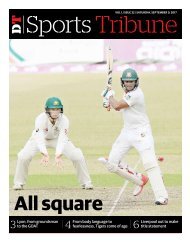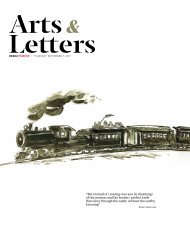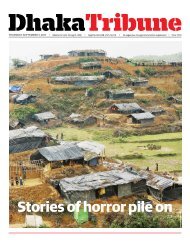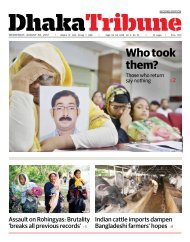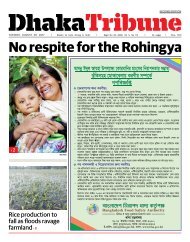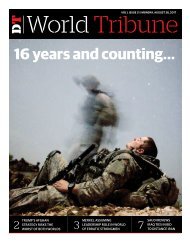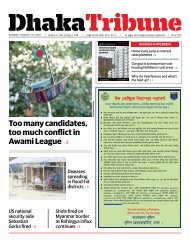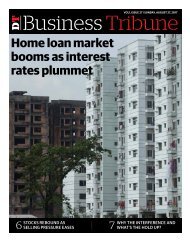e_Paper (23 December 2016)
You also want an ePaper? Increase the reach of your titles
YUMPU automatically turns print PDFs into web optimized ePapers that Google loves.
Feature<br />
17<br />
FRIDAY, DECEMBER <strong>23</strong>, <strong>2016</strong><br />
DT<br />
Discovering<br />
our heritage –<br />
Puthia<br />
• Nahin Taher<br />
History and its beauty, diminishes<br />
with the fall of its place and<br />
time. Once an edifice, which has<br />
paved its way to be marked as a<br />
heritage, falls, it is simply because<br />
it lacks proper maintenance by the<br />
government. A heritage tells us<br />
about its origin; about our origin.<br />
But, unfortunately we neglect our<br />
past and see it decline with time,<br />
eradicating indiscriminately like its<br />
origin. One such land that lost all<br />
is Puthia.<br />
Puthia is an upazila in Rajshahi<br />
district. From Puthia to Rajshahi,<br />
the distance is about 30km. Puthia<br />
can be easily located as it is beside<br />
the Dhaka-Rajshahi highway. In<br />
its initial days, it was a village<br />
of Laskarpur Pargana, named<br />
after Laskar Khan. Puthia can be<br />
accessed by a side road off the<br />
main street, where the temple<br />
complex of Puthia lies, with its<br />
splendid and aristocratic late 19th<br />
century palace, and some of the<br />
finest Hindu temples within the<br />
country.<br />
The Rajbari of Puthia is<br />
surrounded by many<br />
lakes, which act as<br />
boundaries and covers<br />
4.31 acres of land.<br />
The Rajbari was once<br />
surrounded by strong<br />
walls, but the remains of<br />
it has been damaged in<br />
various places now. The<br />
palace is divided into four<br />
courts: Kachari (office)<br />
Angan (court), Mandir<br />
angan or Gobindabari<br />
(temple court), Andar<br />
Mahal (inner quarters)<br />
and Residence of<br />
Maharani Hemanti<br />
Kumari.<br />
Each room of the<br />
Rajbari is built around<br />
the courts in the palace, with the<br />
exception of the kachari angan. The<br />
courts of the palace are one storey<br />
high. The west entrance gate of the<br />
palace leads to kachari angan, while<br />
the other leads to the Temple or<br />
Gobindabari courts. Each portico is<br />
supported by four semi-Corinthian<br />
columns, which are as tall as the<br />
full height of the building. The<br />
upper part of the building is also<br />
supported by four semi Corinthian<br />
pillars. On the east side of the<br />
Rajbari, there is a wooden staircase,<br />
which leads to the upper floor.<br />
There are three rooms of different<br />
sizes and out of these three, two<br />
were used as treasure vaults. In the<br />
west, there are four rooms with<br />
two protruding verandas. Close<br />
to Gobindabari, there are two<br />
small rooms with a veranda.<br />
Sadly, most of the<br />
rooms built on the<br />
eastern and southern<br />
sides of kachari<br />
angan are at ruins.<br />
The northern wing of<br />
the building has two<br />
floors. The upper floor<br />
has six large rooms.<br />
In the hallway of the<br />
Rajbari, there is a wide<br />
veranda with two<br />
balconies on either<br />
sides.<br />
At the centre of<br />
the Rajbari, there<br />
is the Pancharatna<br />
Bara Gobinda temple,<br />
which is beautifully<br />
ornamented with<br />
terracotta. In the<br />
western part of the<br />
Rajbari, there are<br />
two rooms with<br />
several toilets. This<br />
lies mainly in the<br />
Ander Mahal of the<br />
Rajbari. The western<br />
wing, which is mainly<br />
the Andar Mahal, is<br />
impoverished.<br />
The eastern part<br />
of Ander Mahal, where Rani<br />
Hermanta Kumari lived, is one<br />
storey. It has a porch in front, along<br />
with a central reception hall, with<br />
nine big rooms. The wide verandas<br />
have arches in the front and the<br />
back. Most of the roofs are<br />
made out of iron and wood.<br />
Most of the terracotta<br />
relics of the temples that<br />
surround the palace in<br />
Puthia, such as the Chotto Anik<br />
Temple, Boro Gobindo Temple<br />
and Chotto Gobindo Temple, have<br />
been either stolen or destroyed.<br />
The others are at grave risk, as<br />
those are almost at the brink of<br />
decaying, due to high salinity.<br />
Sheer carelessness and<br />
lack of responsibility of the<br />
government and the Department<br />
of Archaeology and History, is<br />
pushing this exquisite site to<br />
lose its existence completely.<br />
Till now, there has not been any<br />
effective initiative taken by them<br />
to preserve the palace and its<br />
surrounding temples. During the<br />
last 30 years, the failure of the<br />
Department and was evident,<br />
when they couldn’t even put up<br />
a mere boundary wall in place for<br />
the protection of the temple and<br />
the palace. Relics, terracotta motifs<br />
and artefacts are being looted<br />
every other day.<br />
This 400 year-old edifice is now<br />
a common site for cattle grazing.<br />
The government has not declared<br />
the importance of Puthia’s heritage<br />
to tourism till date. The beautiful<br />
palace, which once stood with<br />
pride because of it terracotta<br />
motifs, is diminishing with time.<br />
Most of the terracotta motifs are<br />
stolen due to absence of proper<br />
preservation and care from the<br />
Department of Archaeology and<br />
History. •<br />
Photos: Syed Zakir Hossain





